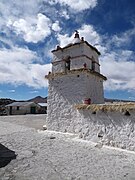Andean Baroque: Difference between revisions
| Line 39: | Line 39: | ||
*There is a presence of local wildlife ([[llama]]s instead of horses and camels, [[guinea pig]] in place of the Paschal Lamb, monkeys, [[opossum]]s, [[tapir]]s, [[cat]]s, along with classic sheep of the shepherds, etc..), And native flora is found in garlands, embroidery, inlays, silver, carvings, etc..) as well as the adoption of vernacular plant replacing the traditional iconography of European; in sculpture and painting are present characters and customs characteristic of the environment; the executor of the work art is the local craftsman of ancient artistic tradition itself, there is an adoption of "naturalization" of European saints, for example, Poland's San Jacinto is called San Jacinto of Yaguachi. |
*There is a presence of local wildlife ([[llama]]s instead of horses and camels, [[guinea pig]] in place of the Paschal Lamb, monkeys, [[opossum]]s, [[tapir]]s, [[cat]]s, along with classic sheep of the shepherds, etc..), And native flora is found in garlands, embroidery, inlays, silver, carvings, etc..) as well as the adoption of vernacular plant replacing the traditional iconography of European; in sculpture and painting are present characters and customs characteristic of the environment; the executor of the work art is the local craftsman of ancient artistic tradition itself, there is an adoption of "naturalization" of European saints, for example, Poland's San Jacinto is called San Jacinto of Yaguachi. |
||
Baroque architecture in Quito stands the [[Church and Convent of St. Francis|Church of San Francisco]], the compañía de Jesús, the Cathedral of Quito, among others. |
Baroque architecture in Quito stands the [[Church and Convent of St. Francis|Church of San Francisco]], the compañía de Jesús, the Cathedral of Quito, among others. |
||
==The churches of the Colca Valley== |
|||
In the [[Colca Canyon|province of Cailloma]] is the valley of Collaguas evangelized by the Franciscans, highlights several Catholic churches located in the towns of [[Yanque District|Yanque]] (Church of the Immaculate Conception of Yanque) Coporaque, [[Cabanaconde]], [[Chivay]], [[Madrigal]] and [[Silvayo]]. |
|||
==Gallery== |
==Gallery== |
||
Revision as of 20:45, 18 August 2012
You can help expand this article with text translated from the corresponding article in Spanish. (August 2012) Click [show] for important translation instructions.
|



Andean Baroque (Spanish: Barroco andino or arquitectura mestiza) is an artistic movement that appeared in the Viceroyalty of Peru (South America) between 1680 and 1780. It is located geographically between Arequipa and Lake Titicaca in what is now Peru and Bolivia, where rules over the highlands and spreads over the entire altiplano. From the Portuguese word barrueco meaning impure, mottled, flamboyant, daring, the most striking example of Andean Baroque art is in religious architecture, where Indian craftsmen gave it a unique character, as happened in the New Spanish Baroque.
Mestizo style
The mestizo style is the application of an American particular decoration to European structural forms, according to Bolívar Echeverría:
"To rescue the social life of the threat of barbarism, and it was impossible to rebuild their ancient worlds, so complex and so fragile, that indigenous layer defeated undertaken in practice, spontaneously, without trumpeting plans or projects, reconstruction or re-creation of European civilization -Iberian- in America.
— Key Latin American baroque.
Origin
The first of the baroque architecture in the Viceroyalty of Peru in 1630 and developed on the Spanish model until the late 17th century. From 1690 differences appear in some regions.
Decorative elements
The originality of this style lies in the decoration, varied, and whose motives respond to four basic types:
- Flora and fauna tropical.
- Mannerism reasons as sirens, masks, etc..
- Columbian reasons: sun, moon, mountain lions, etc..
- Prerrenacentists christian elements.
The mermaid appears in the churches bordering the Lake Titicaca and although it is an item from the classical antiquity, remember the Indian tradition of two fishes women who seduced the god Tunupa.
Arequipa

In Arequipa the key building of mestizo architecture is the church of la Compañía by the architect Gaspar Báez built in 1578.
Quito baroque
.
The extension of the Quito Baroque cover the territories of the former Royal Audiencia of Quito in Spanish colonial times. Especially the Altiplano of Quito and the Andes from Pasto in Colombia to Cajamarca in Peru. Represented in the arts called "Quito School" which was characterized by a high proportion of indigenous quichwas representations.

Features that characterize the indigenous roots in Andean Quito art are:
- There is a "quiteanization" of the characters, many have mixed features and attire local
- These often appear Aboriginal ancestral customs;
- The scenes are located in the ambiance of the Andean landscape, its cities, its architecture;
- There is a presence of local wildlife (llamas instead of horses and camels, guinea pig in place of the Paschal Lamb, monkeys, opossums, tapirs, cats, along with classic sheep of the shepherds, etc..), And native flora is found in garlands, embroidery, inlays, silver, carvings, etc..) as well as the adoption of vernacular plant replacing the traditional iconography of European; in sculpture and painting are present characters and customs characteristic of the environment; the executor of the work art is the local craftsman of ancient artistic tradition itself, there is an adoption of "naturalization" of European saints, for example, Poland's San Jacinto is called San Jacinto of Yaguachi.
Baroque architecture in Quito stands the Church of San Francisco, the compañía de Jesús, the Cathedral of Quito, among others.
The churches of the Colca Valley
In the province of Cailloma is the valley of Collaguas evangelized by the Franciscans, highlights several Catholic churches located in the towns of Yanque (Church of the Immaculate Conception of Yanque) Coporaque, Cabanaconde, Chivay, Madrigal and Silvayo.
Gallery
-
Church of Parinacota
References
